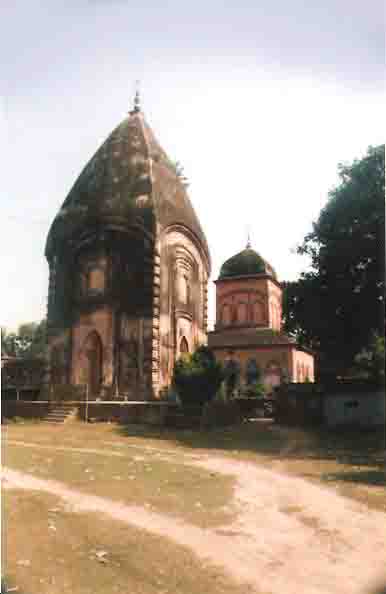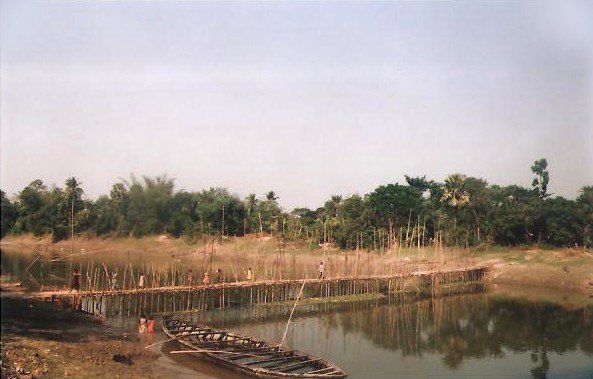| The Telegraph - Metro on Sunday 11th March 2007.
Next weekend you can be at ... Shivniwas...
According to legend, Shivniwas owes its origin to a dream. One in which Lord Shiva appeared before Maharaja Krishnachandra and told him that he was shifting base from Varanasi to his capital. To please the god, the Maharaja set up a new capital at Shivniwas and constructed 108 Shiva temples there. 
Historians offer a more rational explanation. They maintain that in the middle of the 18th Century, Krishnachandra to save his capital Krishnanagar from the invading Marathas (Bargis) shifted it to Shivniwas, which is surrounded on three sides by the river Churni.
The Maharaja christened the new capital Shivniwas, probably after the god. Some historians though claim that it was named after Krishnachandra’s son Shivachandra.
Only two of the 108 temples exist now. One of them houses the largest shivling in eastern India. The two temples, along with a Ram-Sita temple, and the ruins of Krishnachandra’s palace are all that remain of Shivniwas’s glorious past.
A trip to the getaway combines pilgrimage with a journey back in time. The banks of the Churni are perfect for holding picnics.
The best way to get to Shivniwas is take the morning Gede local from Sealdah. You will reach Machdia in about two hours 45 minutes.
A cycle-van ride through tree-lined roads will take you to the Churni bank, where a rickety bamboo and wood structure serves as a bridge. Then follow the mud path to the temple complex.
On the northern side, lies the Ram-Sita temple. Built in 1762, it is more or less intact and houses the idols of Ram and Sita. At the centre of the complex, lies Ragniswar temple. It has a seven-ft high shivling. Built in the same year as the Ram-Sita temple, this structure is in a sorry state and on the verge of collapse.
At the southern end lies the 120-ft high Raj Rajeswar temple. Built in 1754, it has been completely reconstructed and nothing remains of its 250-years-old architecture.
The outside of the temple has morphed into a modern structure, but the octagonal inner chamber has not been modified. A black stone shivling, nine-ft high and 13-ft in circumference, believed to be largest in eastern India, is housed inside. At the back of the shivling, a flight of stairs leads to a platform at a height of about six ft. Devotees pour water on the shivling from the platform. 
After bidding goodbye to the temples, take the dirt road behind the complex. Walk past a phone booth and several houses to a small clearing the remains of the royal palace. Apart from a small roofless room, nothing much is left of the historical structure. Even the room is in precarious condition. Most parts of the ruins are inaccessible due to dense growth of vegetation. The walls of the accessible portion are used to dry cow dung.
The government has made no effort to preserve the historical sites at Shivniwas. But despite all odds, it serves as a perfect spot for a weekend outing.
Going :Take Sealdah-Gede local in the morning and get off at Machdia, about 105 km from Calcutta. The journey takes about two hours and 45 minutes. Cycle vans are available from the station to Shivniwas. The fare is about Rs 5. On the return journey, take a detour to Krishnagar. Buses are regularly available from Shivniwas to Krishnagar. The journey takes about 45 minutes. Trains are available from Krishnagar to Sealdah. The journey takes about two hours and 15 minutes.
Staying :Shivniwas has only a few eateries, so it is best to have your meals at Krishnagar. Don’t forget the famous sarbhaja and sarpuria.
Carrying your food is a good option, especially with the banks of the Churni serving as perfect picnic spots
Metro on Sunday thanks reader RANGAN DATTA for this contribution. Pictures by author |

